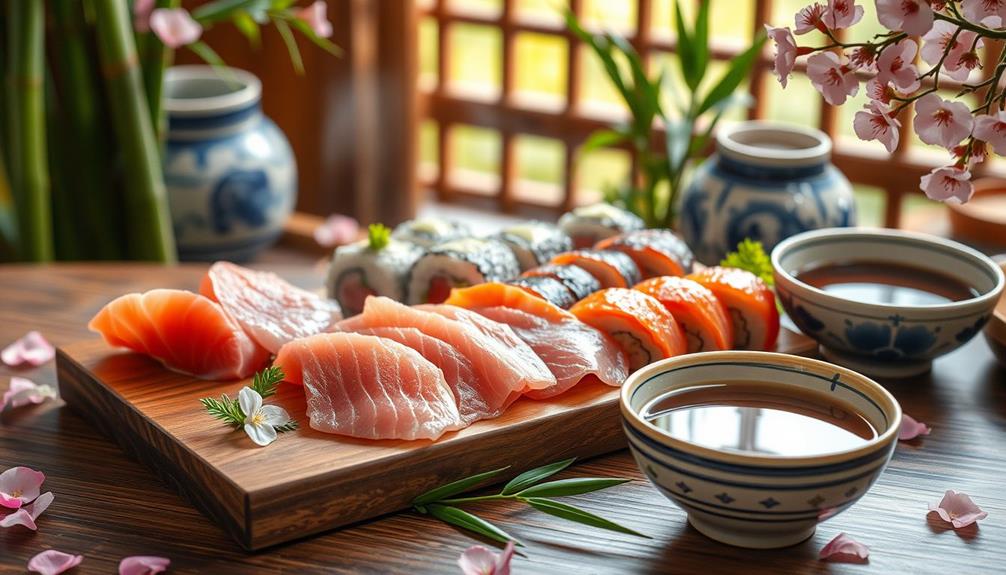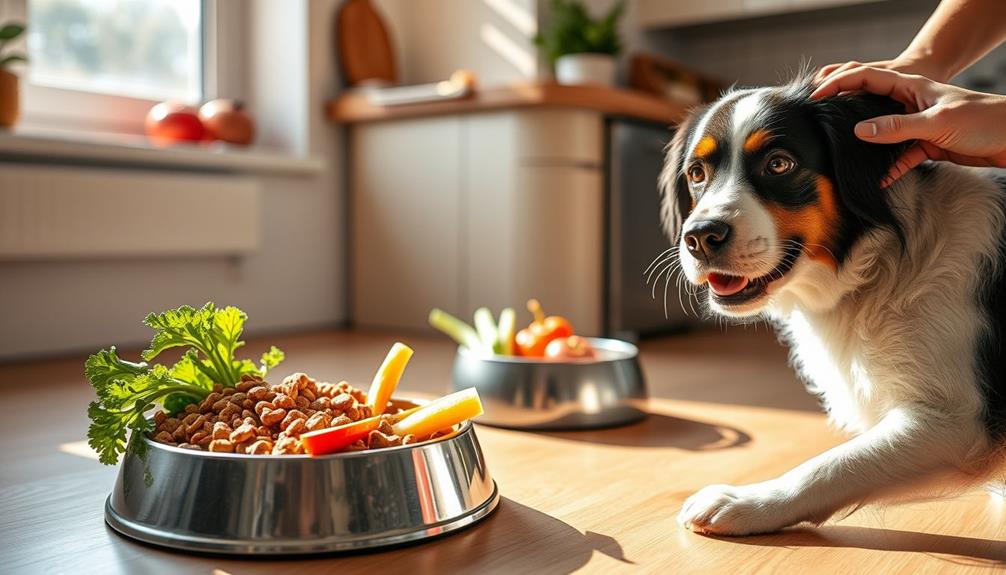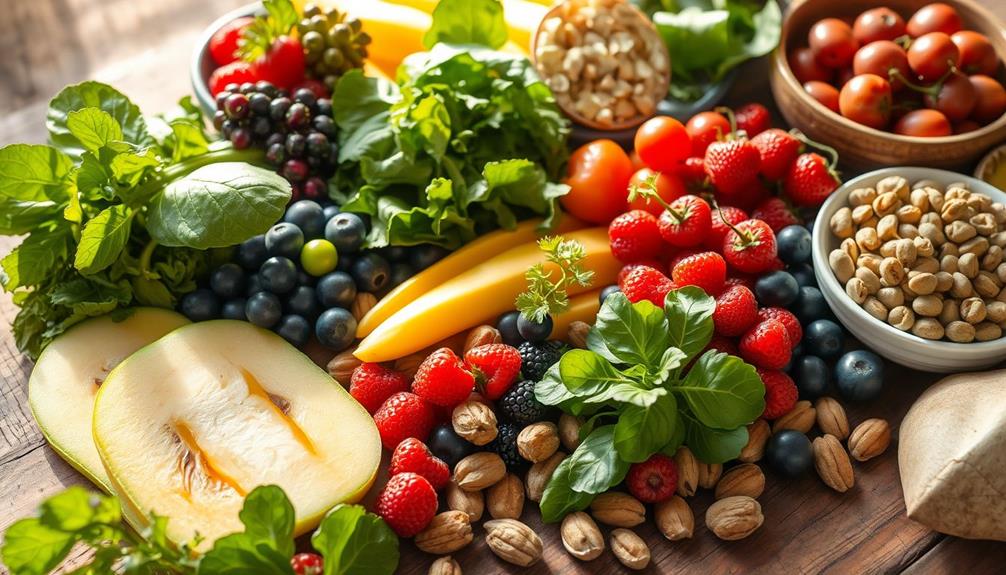Feeding your puppy a raw food diet can be a great choice if you focus on essential nutrients. Aim for a balanced composition: 60-80% muscle meat, 10-25% organ meats, and 15-20% bone. You can include high-quality protein sources like chicken, beef, or fish. Don't forget fruits and vegetables like carrots or spinach for added vitamins! Shift gradually over 7-10 days to avoid digestive upset, and monitor their weight and stools for health signs. This approach helps guarantee a happy, healthy puppy. There's a lot more to discover about raw feeding that can truly benefit your furry friend!
Key Takeaways
- Feed a balanced diet composed of 60-80% muscle meat, 15-20% bone, and 10-25% organ meats for optimal nutrition.
- Include high-quality protein sources like chicken, turkey, beef, and lamb to support muscle development.
- Incorporate raw fruits and vegetables, such as carrots and spinach, to provide essential vitamins and antioxidants.
- Gradually transition to raw food over 7-10 days to minimize digestive upset and monitor your puppy's health closely.
- Consult a veterinarian to tailor the raw diet to your puppy's specific nutritional needs and health status.
Benefits of Raw Feeding
When you choose to feed your puppy a raw diet, you might notice significant benefits that support their growth and overall health. One of the main benefits of raw feeding is improved digestion and nutrient absorption. Puppies thrive on the natural, whole food ingredients, which help them maintain a healthy weight during their rapid growth phases. Additionally, incorporating proper diet guidelines can further enhance the nutritional value of their meals.
Additionally, raw diets often lead to enhanced coat condition and skin health, thanks to the inclusion of natural fats and moisture-rich ingredients. You'll likely notice a shinier coat and healthier skin on your puppy as a result. The natural chewing of raw bones also promotes better dental health, reducing plaque and tartar buildup for stronger teeth.
Moreover, raw feeding can boost your puppy's immune system by eliminating synthetic fillers and providing essential nutrients. This robust immune system can lead to fewer allergies and a lower risk of diabetes later in life.
Studies suggest that adopting a raw diet can even reduce chronic stress-related health issues, contributing to your puppy's overall wellness and well-being. In short, the benefits of raw feeding can set the foundation for a healthy, happy puppy.
Essential Nutrients for Puppies
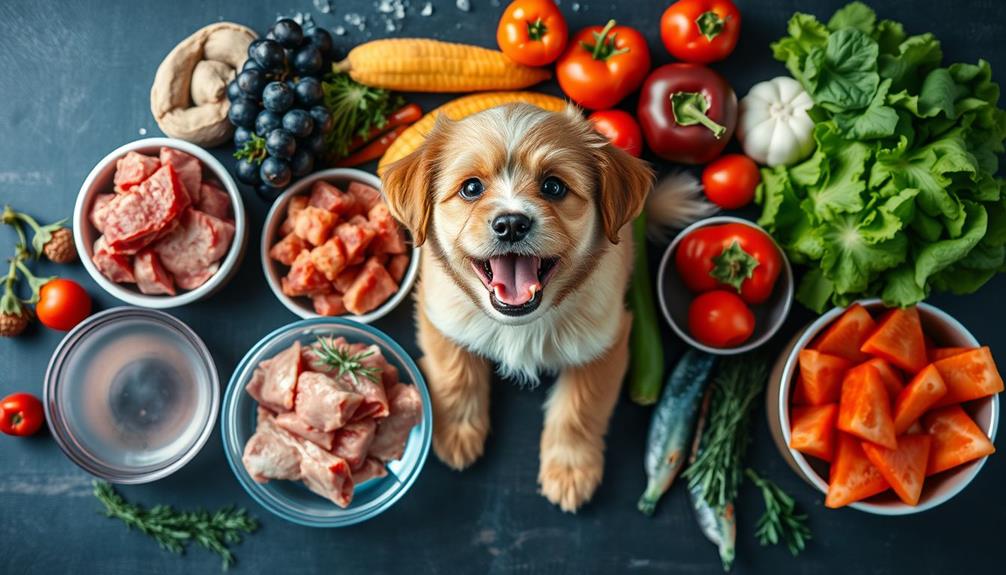
Feeding your puppy a raw diet requires careful attention to the nutrients they need for healthy growth and development. To create a balanced raw diet, you should focus on incorporating the right proportions: 15-20% bone, 60-80% muscle meat, and 10-25% organs. This combination guarantees your puppy receives essential nutrients necessary for peak growth.
Additionally, it's important to be aware of potential health issues related to nutrition, such as the role of gout nutrition in managing overall health.
One key aspect to reflect on is the calcium to phosphorus ratio, which should be approximately 1.4:1. This balance is significant for healthy bone formation and helps prevent deficiencies. High-quality protein sources, such as meat and organ meats, provide essential amino acids that support muscle, skin, and tissue development.
Don't forget about essential fatty acids, particularly omega-3 and omega-6. These fats are critical for reducing inflammation and promoting overall health. Balancing these fatty acids is fundamental to avoid potential chronic health issues.
Incorporating vitamins and minerals from raw fruits and vegetables can further enhance your puppy's diet, supporting immune function and overall well-being. By paying attention to these essential nutrients, you'll meet your puppy's needs and help them thrive on their raw food journey.
Transitioning to Raw Food
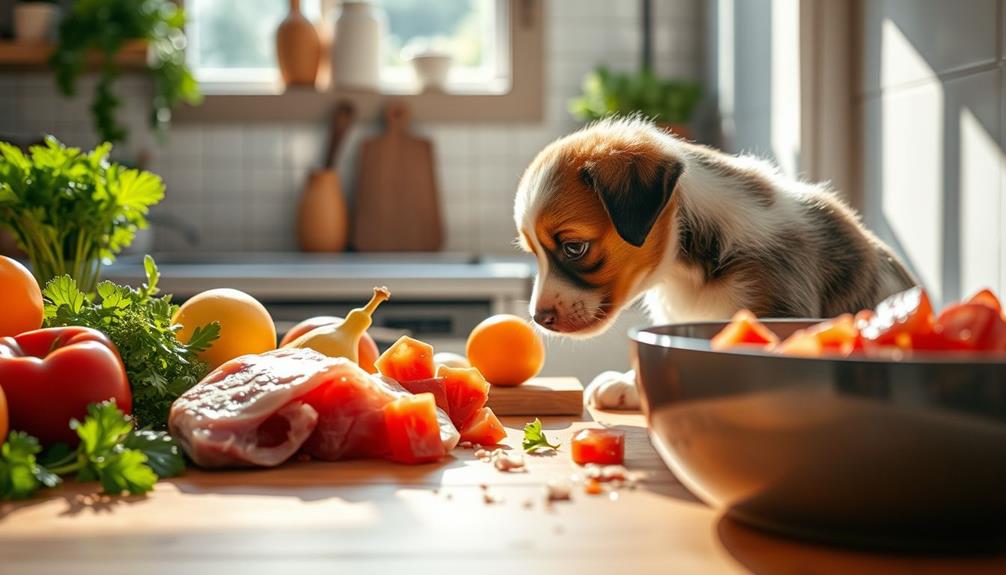
When altering your puppy to raw food, it's essential to do it gradually over 7-10 days to avoid digestive upset.
Starting with small portions of raw food mixed with their current diet allows for a smoother adjustment.
Additionally, making sure you're aware of financial considerations for elderly care can help you manage any related costs, especially if you're also caring for an elderly family member during this time.
Monitor how your puppy responds to the new diet, and customizing their feeding schedule while keeping an eye on their digestive health will help guarantee a smooth shift to their new diet.
Gradual Diet Transition
Shifting your puppy to a raw food diet should be done gradually over a span of 7 to 10 days to guarantee a smooth adjustment for their digestive system. A gradual diet shift minimizes digestive upset and helps your puppy adapt to the new food.
Here's a simple breakdown of the shift plan:
| Days | Food Ratio |
|---|---|
| 1-3 | 25% raw, 75% current |
| 4-6 | 50% raw, 50% current |
| 7-9 | 75% raw, 25% current |
| 10 | 100% raw |
Start by introducing one protein source at a time, which allows you to monitor your puppy for any adverse reactions or allergies. During this shift, keep an eye on your puppy's stool consistency and overall health. Adjust portions as necessary to guarantee they're growing healthily and digesting well.
Monitor Digestive Health
How can you confirm your puppy's digestive health remains stable during the change to a raw food diet? Shifting to a raw diet can be tricky, so it's vital to monitor your puppy's digestive health closely.
Incorporating high-quality protein sources is essential for energy levels, and making sure they receive natural ingredients can promote overall health and wellness healthy dog snacks.
Here are three key areas to keep an eye on:
- Stool Consistency: Check your puppy's stool regularly. Healthy stools should be firm and well-formed. If you notice diarrhea or loose stools, it may indicate intolerance to the new ingredients or an imbalance in the diet.
- Appetite and Energy Levels: Watch for changes in your puppy's appetite and energy. A decrease in either can suggest digestive discomfort or inadequate nutrition, signaling a need to adjust your approach to feeding dogs.
- Signs of Allergies: Keep an eye out for any signs of food allergies, like itching or skin irritations, as you introduce new proteins.
Regular weight checks are also essential to confirm your puppy is growing appropriately.
Customize Feeding Schedule
Changing your puppy to a raw food diet requires careful planning to guarantee they adapt smoothly. Start by gradually altering over 7-10 days. Mix small portions of the raw food with their current food to assess tolerance and prevent digestive upset.
During this alteration, it's essential to follow an appropriate feeding schedule. For puppies aged 8 to 16 weeks, aim for four meals a day. From 16 weeks to 12 months, reduce this to three meals, and finally, switch to two meals daily from 12 to 18 months. Understanding the importance of key domains of development will help you make sure your puppy receives the right nutrition during these formative stages.
While feeding your puppy a raw diet, monitor their weight weekly and adjust the amounts based on their ideal adult weight, which is usually around 2-3% of their body weight. Introduce one protein source at a time and watch for any signs of digestive upset or allergies.
Use specific feeding guidelines based on their age, making certain they receive a balanced diet during these critical growth phases. For example, feed puppies aged 2-4 months about 8-10% of their current weight, and those aged 4-6 months around 4-6%. This structured approach will help your puppy thrive on their new diet.
Determining Portion Sizes
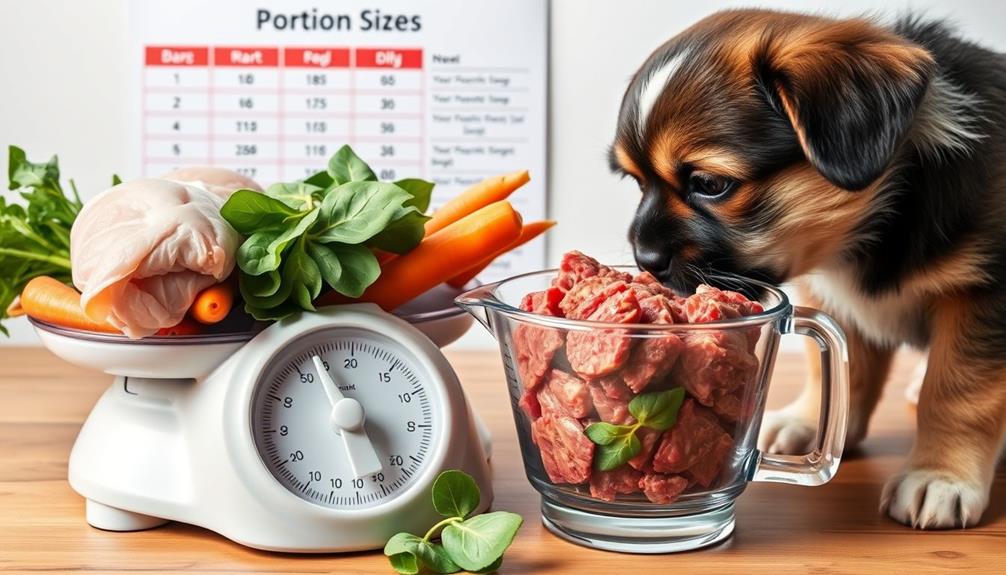
When figuring out portion sizes for your puppy, it's important to contemplate their expected adult weight and age. Puppies need specific amounts of food based on their growth stage, so following accurate feeding guidelines can make a big difference.
Additionally, understanding your puppy's nutritional needs is vital for their development, much like how budgeting is essential for financial health.
Here's a quick breakdown to help you determine the right portion sizes:
- Age Matters: For puppies aged 2-4 months, feed them 8-10% of their current weight. From 4-6 months, reduce this to 6-8%.
- Daily Intake: Generally, you should aim for 2-3% of their expected adult weight daily. Younger puppies may require up to 10% of their current weight, while older ones need less.
- Meal Frequency: Divide the total daily food amount into multiple meals. Puppies should eat three times daily until six months old, then shift to twice daily from 12 to 18 months.
Monitoring Puppy Health
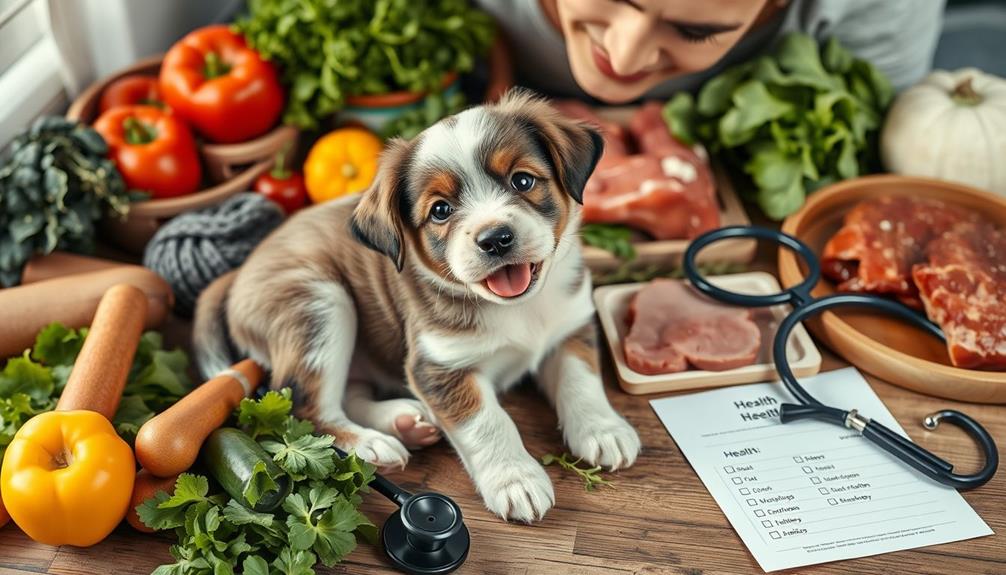
Monitoring your puppy's health is key to guaranteeing they thrive on a raw food diet. Regular weight checks are essential for tracking puppy growth and determining if they're at a healthy weight. Aim for a visible waist and rib visibility.
It's important to keep an eye on any potential gastrointestinal issues, as gastrointestinal issues can arise from dietary changes. Pay close attention to their stool consistency; firmer stools usually indicate better digestibility and nutrient absorption from the raw diet.
Adjust feeding amounts based on age, starting with 8%-10% of their current weight for puppies aged 2-4 months, and decrease as they grow. It's vital to monitor for signs of dietary imbalances, such as digestive upset or fluctuations in energy levels. If you notice any changes, be ready to adjust their diet accordingly.
To help with this process, consider keeping a food journal. This can track dietary changes and their effects on your puppy's health, allowing for better management of their nutrition over time.
Addressing Picky Eaters
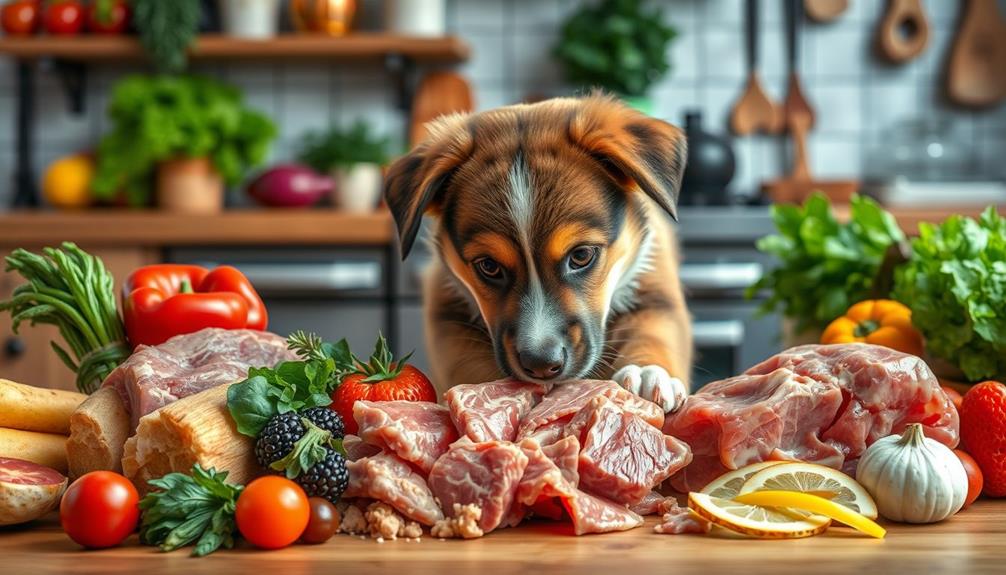
If your puppy's a picky eater, it might stem from early exposure to overly tasty kibble.
To encourage a diverse diet, you can start by introducing a variety of proteins and fresh foods gradually.
Additionally, some essential oils, like peppermint oil, can aid in digestion and might help stimulate your puppy's appetite.
Consistency in mealtime routines can also help your pup develop better eating habits and reduce those finicky tendencies.
Understanding Picky Eating
Puppies can be notoriously picky eaters, a behavior often rooted in their previous experiences with overly palatable kibble. When moving to a raw food diet, it's not uncommon for them to turn their noses up at fresh options.
To help your puppy embrace a variety of protein sources and combat picky eating, consider these tips:
1. Introduce Variety Early: Start with different protein sources from the beginning. This helps them develop a taste for diverse foods and reduces their chances of becoming picky.
Additionally, understanding the mechanics of brewing methods can provide insights into creating appealing meals that engage your puppy's senses.
2. Maintain Consistent Feeding Schedules: Puppies thrive on routine. By feeding them at the same times each day, you'll encourage a regular eating habit and reduce fussiness.
3. Create a Relaxed Feeding Environment: Make sure mealtime is calm and free from distractions. Avoid excessive interaction during meals, as this can create stress and lead to picky eating.
Encouraging Diverse Diets
To tackle picky eating in your puppy, it's crucial to mix things up with their diet right from the start. Introducing a variety of fresh, whole food options early on fosters acceptance of diverse flavors and textures. This exposure helps your puppy develop a preference for different proteins, making the change to a balanced raw diet smoother.
Additionally, engaging in heartfelt expressions of love can create a positive environment around mealtime, encouraging your puppy to explore and enjoy their food.
A consistent and varied diet can establish healthy eating habits, reducing the chances of food aversions later in life. Start by gradually incorporating new protein sources and supplements, allowing your puppy's digestive system to adjust without causing upset.
Be mindful that some puppies may develop picky behaviors, often due to previous exposure to overly palatable kibble. By ensuring your puppy's meals are interesting and diverse, you can help prevent this issue.
Engaging with community support groups, like The Pack, can offer insights and shared experiences on maintaining a diverse diet for your puppy.
Gradual Food Introduction
When introducing raw food to a picky eater, it's essential to do so gradually. This approach minimizes digestive upset and encourages acceptance. Over a span of 7-10 days, mix small portions of raw food with your puppy's current diet.
Here's how to effectively implement a gradual food introduction:
- Start Simple: Begin with a single protein source to assess your puppy's tolerance.
- Monitor Reactions: Carefully observe your puppy's reaction to new foods. If you notice intolerance or allergies, adjust accordingly. Keeping a log of these changes can be incredibly helpful.
- Variety Matters: Once your puppy adjusts to the first protein, gradually introduce different sources. A mix of meat, organs, and bones fosters acceptance and helps create a balanced nutrient profile.
Using fresh, appealing raw foods can also combat pickiness, especially if their previous kibble was overly palatable.
Common Misconceptions

Many dog owners hold misconceptions about raw food diets for their puppies, often leading to hesitancy in making this dietary switch. One common misconception is that raw diets are unsafe due to bacteria. However, when you handle and source high-quality ingredients properly, these risks diminish considerably.
Another myth is that raw food lacks vital nutrients. In reality, a well-balanced raw diet for dogs can provide all the necessary vitamins and minerals if formulated correctly.
Many people assume that all dogs can thrive on the same raw diet, but dietary needs actually vary by breed, age, and individual health conditions. This means you'll need to tailor meal plans to meet your puppy's specific requirements.
Additionally, some owners think raw feeding is too expensive and time-consuming. In truth, bulk purchasing and subscription services can make it affordable and save you time on meal prep.
Lastly, there's a belief that puppies can't eat raw food until adulthood. Contrary to this myth, puppies can benefit from a raw diet designed specifically for their nutritional needs from an early age.
It's crucial to debunk these common misconceptions to make informed choices for your puppy's health.
Safety and Hygiene Practices
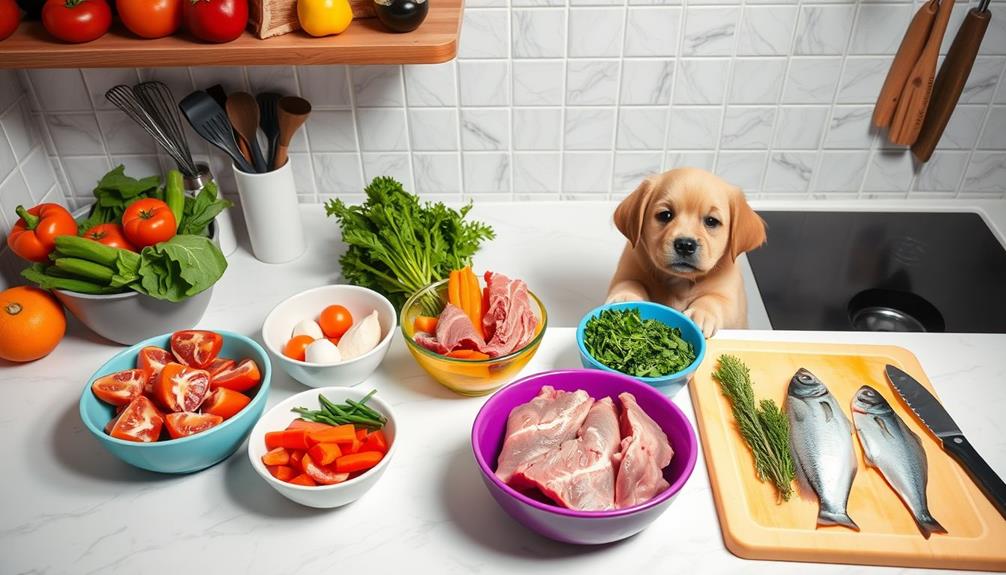
Raw food diets for puppies can be beneficial, but guaranteeing safety and hygiene is vital to prevent health risks. Proper handling and cleanliness can help you avoid bacteria like Salmonella and E. coli that may contaminate surfaces.
Here are three significant safety practices to follow:
- Wash Your Hands: Always wash your hands thoroughly before and after handling raw food. This simple step helps prevent the spread of harmful bacteria.
- Clean Feeding Bowls and Surfaces: After feeding your puppy, clean their bowls and any surfaces with hot, soapy water. This eliminates residual bacteria and keeps your kitchen safe.
- Store Raw Meat Properly: Keep raw meat in sealed containers in the refrigerator or freezer. Use refrigerated meat within 1-2 days, while frozen meat can last for several months.
Also, source raw food from reputable suppliers to guarantee safe handling practices.
Monitor your puppy's health during the change to a raw diet and consult your vet for guidance. By maintaining proper safety and hygiene, you can enjoy the benefits of a raw food diet while keeping your puppy healthy and safe.
Veterinary Recommendations
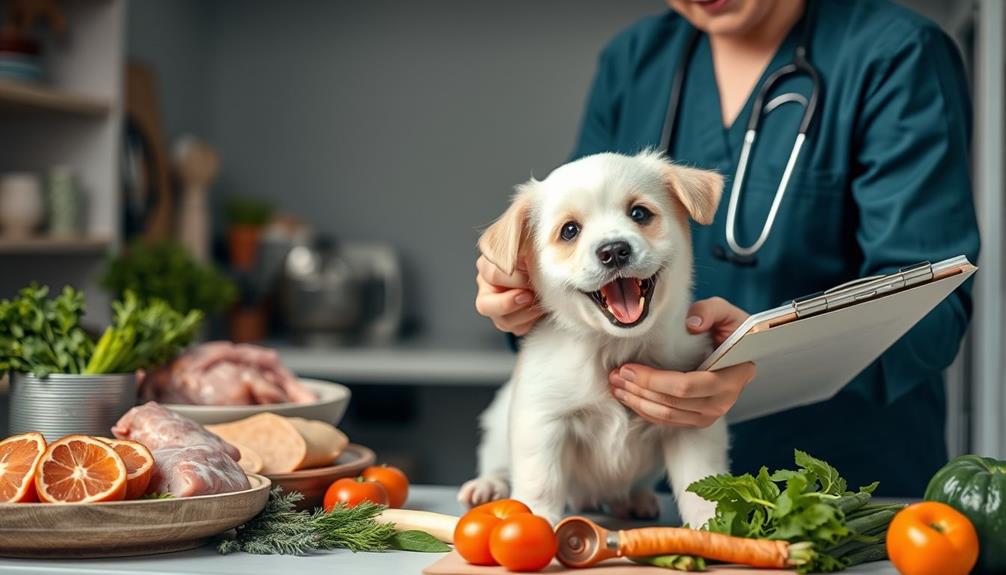
Before you commence a raw food diet for your puppy, it's important to seek guidance from a veterinarian or a pet nutritionist. Major veterinary associations strongly recommend this step to guarantee your puppy receives a balanced diet that meets their nutritional needs.
A well-structured raw diet should include the right ratios of meat, bones, and organ meats, which are crucial for a growing puppy.
Many veterinarians voice concerns about the potential health risks associated with raw feeding, such as bacterial contamination. It's necessary to monitor your puppy closely for any signs of digestive upset or illness. Regular check-ups with your vet are key to evaluating your puppy's growth and overall health while on a raw diet.
Additionally, veterinary recommendations often highlight the importance of including nutritional supplements. These can help address common deficiencies in vitamins and minerals that raw food alone mightn't provide.
Popular Raw Diet Types
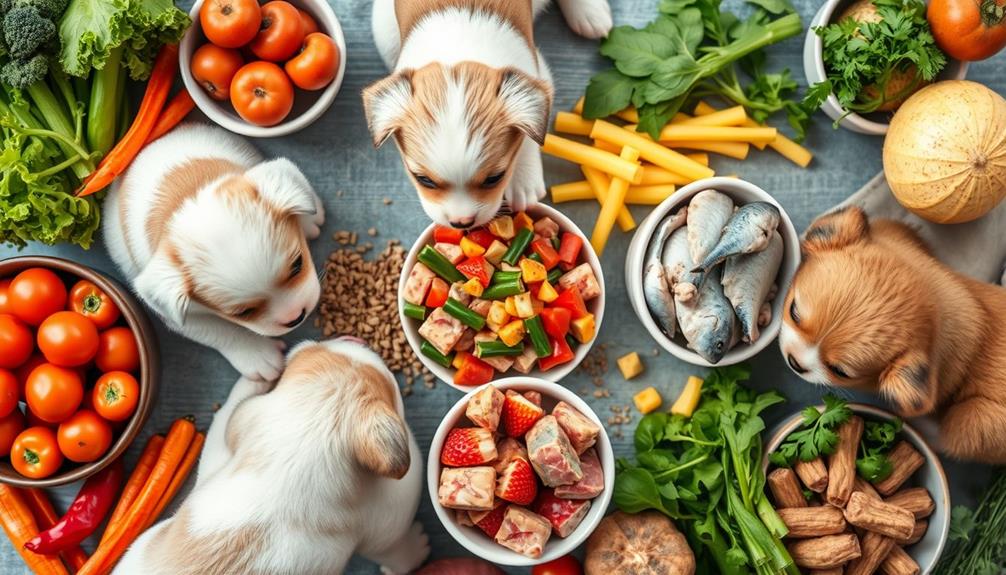
When considering raw diets for your puppy, you'll come across a variety of popular types, each with unique ingredients and meal plans.
From the BARF diet that balances meat with fruits and veggies to homemade options that you can customize, there's a lot to explore.
Understanding these different approaches will help you create a balanced and nutritious feeding routine for your furry friend.
Types of Raw Ingredients
Puppies thrive on a variety of raw ingredients that cater to their nutritional needs, and understanding these components is fundamental for any pet owner.
A well-rounded raw dog food diet includes several key elements that contribute to a balanced diet, ensuring your puppy gets all the nutrients they require for healthy growth.
Here are three types of raw ingredients you should consider:
- Raw Meat: High-quality proteins such as chicken, turkey, beef, lamb, and fish are necessary. They provide amino acids critical for your puppy's development.
- Organ Meats: Incorporating organ meats, like liver and heart, is significant. These nutrient-dense options supply essential vitamins and minerals, with liver making up about 10% of the diet.
- Raw Bones and Vegetables: Meaty, non-weight-bearing bones contribute necessary calcium and phosphorus, while veggies like carrots and spinach offer antioxidants. Aim for 10-20% of your puppy's intake to be from these sources.
Balanced Raw Meal Plans
A balanced raw meal plan is vital for your puppy's healthy development, and choosing the right diet type can make all the difference. Typically, a balanced raw meal plan consists of 60-80% muscle meat, 10-25% organ meats—where liver should make up about 10%—and 15-20% raw bone to provide necessary calcium and phosphorus.
Two popular raw diet types are the Biologically Appropriate Raw Food (BARF) diet and the Prey Model Raw (PMR) diet. The BARF diet includes raw meat, bones, fruits, and vegetables, while the PMR diet mimics the diet of wild canines, focusing on whole prey animals.
For peak nutrition, guarantee your puppy's meal plan maintains a calcium to phosphorus ratio of about 1.4:1, which is vital for healthy bone development.
Also, don't forget to introduce a variety of protein sources like chicken, beef, and fish. This diversity not only enhances the nutrient profile but also helps prevent picky eating behaviors.
Always consult with a veterinarian or canine nutritionist to guarantee your balanced raw meal plans meet AAFCO guidelines for complete and balanced nutrition.
Frequently Asked Questions
What Raw Foods Are Good for Puppies?
When considering raw foods for your puppy, focus on high-quality proteins like chicken, beef, and fish. Don't forget organ meats for essential nutrients, and add some fruits and veggies for balanced nutrition and antioxidants. A raw food diet for dogs is a great way to provide them with the natural and nourishing nutrients they need to thrive. By choosing high-quality, whole foods and avoiding processed ingredients, you can ensure that your puppy is getting the best nutrition possible. Just be sure to consult with a veterinarian or canine nutritionist to ensure that you are meeting all of your puppy’s specific dietary needs when implementing a raw food diet for dogs.
Do Puppies Need Special Raw Food?
Yes, puppies need special raw food. Their diets must be higher in protein and fat, including muscle meat, bones, and organ meats. This guarantees they get essential nutrients for healthy growth and development.
What Can I Add to My Puppies Raw Food?
You can add finely chopped veggies like carrots and spinach, fruits like blueberries, healthy fats such as fish oil, organ meats for nutrients, and calcium sources like raw meaty bones to enhance your puppy's raw diet. When weaning puppies onto raw food, it’s important to gradually introduce them to different ingredients to avoid upsetting their sensitive stomachs. Start by mixing small amounts of raw food with their current diet and slowly increase the proportion over time. Additionally, consulting with a veterinarian or canine nutritionist can ensure that your puppy is receiving a balanced and nutritious diet during this transition.
Do Vets Recommend Raw Food for Puppies?
Puppies are like delicate flowers needing proper nutrients to bloom. Vets generally don't recommend raw food for them, citing risks of deficiencies and bacterial contamination. Instead, they suggest balanced diets tailored to your pup's growth needs.
Conclusion
Incorporating raw food into your puppy's diet can lead to healthier growth and development, often resulting in shinier coats and increased energy. Did you know that 74% of dog owners report noticeable improvements in their pets' overall health after changing to a raw diet? By carefully adapting your puppy and monitoring their health, you can access the benefits of raw feeding while ensuring they thrive. Remember, a well-planned raw diet can make a world of difference for your furry friend!


